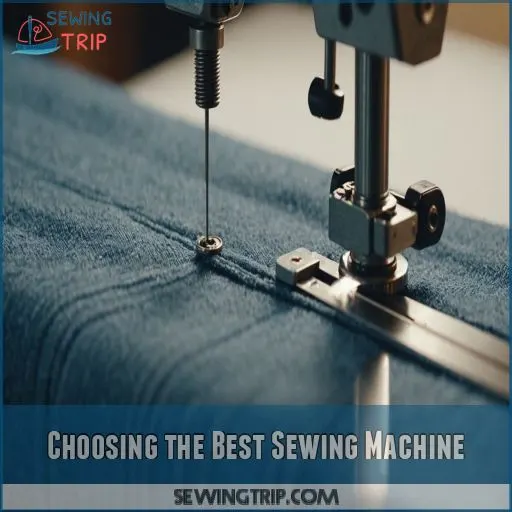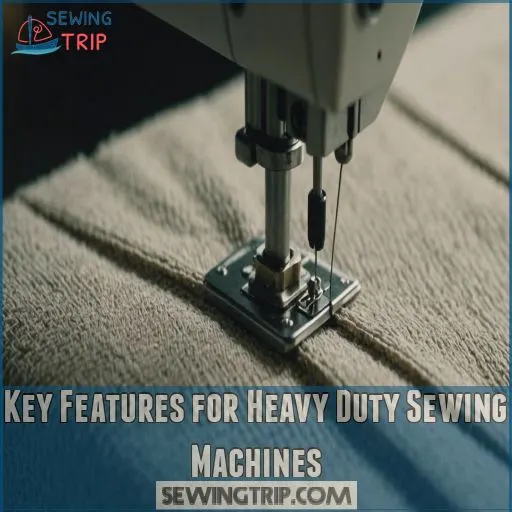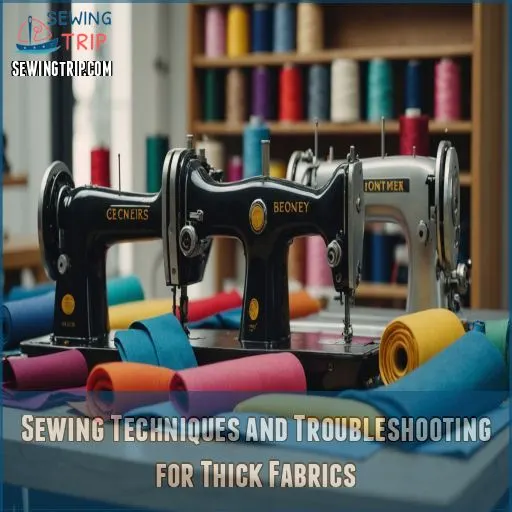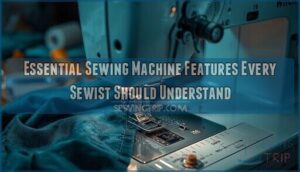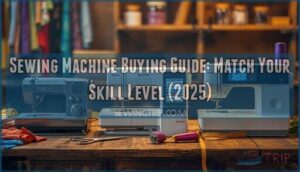This site is supported by our readers. We may earn a commission, at no cost to you, if you purchase through links.

These features mean you won’t bog down in layers of denim or leather.
Look for reliable presser foot pressure and a smooth feed dog system; they’ll save the day by preventing skipped stitches.
Whether you choose a mechanical or computerized model depends on your sewing style and project complexity.
Ready to conquer those tough fabrics? There’s more to explore!
Table Of Contents
Key Takeaways
- When you’re dealing with thick fabrics, a sewing machine with a sturdy metal frame and a powerful motor is your best friend. Think of it as the muscle car of sewing—built to power through tough layers like denim or leather without slowing down.
- Choosing between a computerized or mechanical machine depends on your sewing style. If you like fancy features and precision, go digital. But if you want simplicity and reliability, a mechanical model is your perfect match.
- The right needle and presser foot make all the difference. Consider using a walking foot to keep those thick layers in line, and pick a sturdy needle, like size 100/16, to avoid any fabric grumbling.
- Don’t let your fabric throw a tantrum! Control speed and tension adjustments wisely to prevent fabric shifting or skipped stitches. Your sewing machine should glide smoothly through the project, not battle it.
Choosing the Best Sewing Machine
Choosing the right sewing machine for thick fabrics can make all the difference in your sewing projects.
From sturdy metal frames to powerful motors, there are several key factors to keep in mind when selecting the best heavy-duty machine for your needs.
Construction and Build Quality for Thick Fabrics
When tackling thick fabrics, construction is king.
Opt for a heavy-duty sewing machine boasting a metal frame and a sturdy sewing bed.
Make sure the presser foot can handle the pressure and the feed dog system is reliable.
A well-sized needle plate and throat space offer control, while a powerful motor conquers those stubborn layers with ease.
Consider this your fabric fortress!
Computerized Vs. Mechanical Sewing Machines for Heavy Duty
Choosing between a computerized and mechanical heavy duty sewing machine can be tricky.
Computerized machines offer advanced features with a walking foot and stitch precision, but they come with a higher price and possibly a steep learning curve.
Mechanical options are durable and reliable, perfect for heavy fabric, offering straightforward maintenance, though with fewer features.
Consider your user experience needs.
Sewing Type and Stitch Options for Thick Materials
Now that you know whether to go for a computerized or mechanical option, let’s talk about sewing types and stitch options for thick materials.
Your sewing machine should offer:
- Variety of Stitch Types: Accommodate different fabrics and seam allowances.
- Adjustable Stitch Length: Helps make sure better stitch quality on heavy fabrics.
- Compatible Needle Sizes: Handles multiple layers with ease.
Throat Plate and Working Space for Large Fabrics
The throat plate and working space of your sewing machine are important when tackling large, bulky fabrics. Look for a wide throat plate that provides ample clearance to accommodate thick materials without bunching or jamming. An extension table can also expand your workspace, making it easier to maneuver and support heavy projects.
Throat Plate Width Working Space
Free Arm Use
Speed and Tension Adjustment for Thick Fabrics
Having ample working space is nice, but don’t speed away yet!
Controlling speed and tension is key when sewing thick fabrics.
Consider:
- Speed Control: Adjust your sewing machine’s speed for thicker materials.
- Tension Adjustment: Alter tension for perfect stitch quality.
- Needle Size: Match the needle size to your fabric type for smooth operation.
Keep these in your toolkit for sewing success!
Key Features for Heavy Duty Sewing Machines
When you’re hunting for a heavy-duty sewing machine, look for a strong metal frame since it’s like the backbone of your setup, keeping everything stable.
It’s also key to find a model with a powerful motor, which is like the muscle, ensuring it can tackle all those thick, tough fabrics without breaking a sweat.
Metal Frame and Sturdy Build for Stability
To tackle thick fabrics, a sewing machine needs a sturdy build.
Picture a metal frame as the backbone, offering frame durability and stability benefits.
The impact on sewing? More control and precision, especially for heavy-duty projects like denim.
An industrial-grade sewing machine stands firm like a rock, ensuring your creations don’t lose their thread halfway through!
Powerful Motor for Smooth Sewing Through Thick Fabrics
A powerful motor is the heart of any heavy-duty sewing machine, ensuring smooth stitching even through the thickest fabrics, like the Singer 241-12’s oil bath lubrication system. https://sewingtrip.com/singer-commercial-sewing-machine-model-241-12/.
Look for machines with:
- High torque for effortless penetration through multiple layers
- Adjustable speed control for precision on delicate or heavy materials
- Robust construction to handle the extra strain of thick projects
Multiple Layer Sewing Capability for Heavy Duty Projects
After discussing motor strength, picture tackling those heavy-duty projects with ease.
Like a well-trained dog, a solid feed dog system makes sure smooth sailing as your quilting machine gracefully handles multiple layers.
Whether it’s denim or canvas, having an extension table adds workspace, making these complex sewing projects feel more like a relaxing stroll than a challenging task.
Needle System and Compatibility for Thick Fabrics
Needles are like stitches’ trusty sidekicks.
For thick fabrics, choosing the right needle system is a game changer.
Consider needle types and sizes compatible with your machine.
Brands often offer durable needles.
Needle threading shouldn’t be a wrestling match.
Reliable systems in the best sewing machines for thick fabrics make for smooth sewing, whether tackling outdoor canvas or marine projects.
Top 5 Sewing Machines for Thick Fabrics
If you’re tackling thick fabrics, not all sewing machines can handle the pressure, but don’t worry—I’ve got you covered with the top five picks.
Imagine your sewing machine cruising through denim like a knife through butter; these models make it feel that effortless.
1. Singer Heavy Duty Sewing Machine
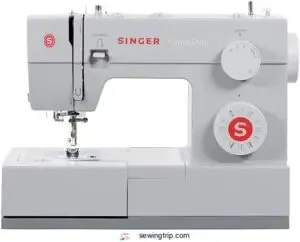
The Singer Heavy Duty 4423 sewing machine is a workhorse that can tackle even your toughest projects.
With a heavy-duty metal frame and powerful motor, this machine sews through thick fabrics like a dream.
You’ll love the 23 built-in stitches and 40 stitch functions, giving you the freedom to get creative.
The automatic needle threader takes the hassle out of setup, while the extra-high sewing speed of 1,100 stitches per minute saves you time.
Whether you’re sewing denim, leather, or canvas, the Singer 4423 is up for the challenge. (Source)
Best For: The Singer Heavy Duty 4423 is best for beginners and experienced sewers who need a reliable machine for a variety of projects, especially those involving thick fabrics.
- Powerful motor for tackling tough fabrics
- 23 built-in stitches and 40 stitch functions for variety
- Automatic needle threader for easy setup
- Some users report thread tension issues
- Foot pedal control can be jumpy
- Limited fancy stitches for advanced users
2. Brother ST371HD Sewing Machine

Looking for a reliable sidekick in your battle against thick fabrics? Brother ST371HD steps up with 37 built-in stitches and an auto-sized buttonhole, perfect for a wide range of materials from lightweight cotton to sturdy upholstery. It’s like having a Swiss Army knife in your sewing arsenal.
With ease, thread your needle as the automatic needle threader does its magic.
Just be aware, the presser foot lifter might feel a bit flimsy.
Remember, this beast isn’t European voltage-friendly, so keep it stateside!
Best For: The Brother ST371HD is best for beginners and intermediate sewers who want a versatile and easy-to-use machine for a variety of projects.
- Easy to thread and wind bobbins.
- Handles a wide range of fabrics.
- Quiet operation.
- The presser foot lifter may be flimsy.
- The needle threader may not always work properly.
- Not compatible with European voltage.
3. Juki TL 2010Q Sewing Quilting Machine
Consider the Juki TL 2010Q if you’re tackling thick fabrics; it’s like sewing nirvana in a compact package.
Weighing in at 39 pounds, this machine handles challenging materials with ease, providing precise, serene sewing experiences.
You’ll appreciate its high-speed prowess without the sonic chaos.
While threading might test your patience initially, stick with it—mastery awaits. Daily oiling is needed, so keep your apron on!
Figuring out how to use the machine is worth it for its excellent stitch quality and durability. Happy sewing!
Best For: The Juki TL 2010Q is best for quilters and sewers who work with thick fabrics and need a heavy-duty machine that delivers precise stitching.
- Handles thick fabrics with ease.
- Produces high-quality stitches.
- Offers a quiet sewing experience, even at high speeds.
- Threading and bobbin loading can be challenging.
- Requires daily oiling.
- Some users have reported needle breakage.
4. Janome HD1000 Black Edition Sewing Machine
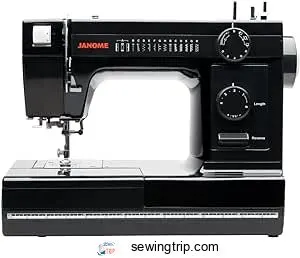
When you’re tackling thick fabrics, the Janome HD1000 Black Edition is your trusty steed.
With its industrial-grade construction and aluminum interior frame, this sewing machine gallops seamlessly through demanding projects like sewing thick leather.
While the bobbin winding can be a bit of a tricky dance, this machine’s reliability shines like a beacon, making it worth mastering.
Users appreciate its durability but keep that thread tail just right to avoid jams.
Best For: The Janome HD1000 Black Edition is best for sewers who need a sturdy and reliable machine for tackling thick fabrics.
- Industrial-grade construction for durability
- Easy-to-use threader for convenience
- Lightweight for its size, making it portable
- Bobbin winding can be tricky and require careful attention
- The machine is sensitive to thread tail length
- Some users have reported issues with jamming
5. JUKI TL 2000Qi Sewing Quilting Machine
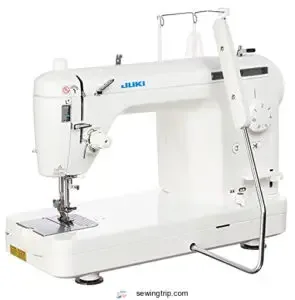
The JUKI TL 2000Qi is a heavy-duty workhorse that’ll make quick work of your thick fabric projects.
Its powerful motor and all-metal construction guarantee smooth, vibration-free sewing, even through multiple layers.
The tapered head provides an unobstructed view, while the adjustable presser foot pressure keeps those stubborn fabrics in check.
And with that lightning-fast 1,500 stitches per minute, you’ll zip through your work in no time.
Plus, the automatic thread cutter is a game-changer – just a quick tap of your foot, and you’re ready to roll.
This JUKI is a quilter’s dream come true.
Best For: The JUKI TL 2000Qi is best for quilters who need a powerful and reliable machine for heavy-duty projects.
- Heavy-duty construction for long-lasting performance.
- Fast sewing speed for efficient quilting.
- Automatic thread cutter for quick and easy thread trimming.
- Only does straight stitch.
- May need a voltage converter for use in the UK.
- Some users have reported issues with thread coming unthreaded.
Sewing Techniques and Troubleshooting for Thick Fabrics
Ready to conquer thick fabrics? We’ll guide you through essential techniques and troubleshooting tips, ensuring your sewing projects go off without a hitch.
except for the occasional needle mishap that’s part of the charm.
Trimming Seam Allowances for Reduced Bulk
Making an elephant feel like a feather might be an exaggeration, but reducing bulk certainly makes sewing thick fabrics manageable.
Trim your seam allowance width carefully; it’s like a magic shrinking potion for bulky seams.
Use pattern adjustments to snip down excess fabric types.
Employ sewing techniques like a walking foot or roller foot and adjust your stitch length and width for smoother stitching.
Choosing the Right Needle for Thick Fabrics
Choosing the right needle for thick fabrics can make or break your stitching game.
Aim for a larger needle size, like 100/16, which penetrates denim or vinyl with ease.
Pair your needle with a strong thread type and make sure your stitches look good.
Remember, the needle’s shank and point style affect performance, much like the engine in your faithful old car.
Setting Up the Machine for Thick Fabrics
Prepare your machine for thick fabrics by adjusting the stitch length – a longer stitch is ideal.
Make sure the presser foot is level and the feed dogs are engaged to prevent fabric bunching.
Additionally, consider using a walking foot or roller foot to help feed the layers smoothly through the machine.
With the right setup, you’ll be sewing through thick materials like a pro!
Stitching With the Handwheel for Control
Think of the handwheel as your sewing machine’s trusty sidekick.
For tricky fabrics, engage slow stitching with the handwheel for fine control. Maintain fabric tension and use manual feeding to enhance stitch quality.
Adjust your stitch length and width to keep built-in stitches and reverse stitching steady. It’s like coaxing a stubborn mule—patience and precision win the day!
| Handwheel Techniques | Stitch Length | Stitch Width |
|---|---|---|
| Slow Stitching | Adjustable | Adjustable |
| Fine Control | 2.5-3.5mm | 4-6mm |
| Manual Feeding | Customizable | Customizable |
| Fabric Tension | Balanced | Standard |
Troubleshooting Common Issues With Thick Fabric Sewing
When working with thick fabrics, it’s easy to feel like you’re wrestling a stubborn octopus.
If stitches skip or fabric bunches, check your needle selection and make sure the feed dog is engaged. Adjust presser foot pressure and consider a walking foot.
For sewing machine repair, a nudge to threading, like guiding a sleepy toddler, can also solve the hiccups.
Frequently Asked Questions (FAQs)
What kind of sewing machine for thick fabric?
You need a sewing machine with a sturdy metal frame, a powerful motor, and multiple-stitch capabilities for thick fabrics.
Consider models like Singer 4432, Brother ST371HD, or Janome HD
These bad boys will tackle tough fabrics easily!
How thick of fabric can a sewing machine sew?
Wrestling with thick fabric, a sewing machine’s like a trusty steed—most heavy-duty machines handle up to 6-8 layers.
Choose models with strong needles, powerful motors, and adjustable presser feet to tackle these projects smoothly.
What sewing machine foot to use for thick fabric?
Consider using a walking foot for thick fabrics.
It’s like having an extra hand guiding your fabric smoothly.
This foot helps prevent shifting and bunching, ensuring your stitches stay even and frustration-free.
Can material be too thick for sewing machine?
If the fabric is too thick, it can overwhelm even the most powerful sewing machine.
Stick to the manufacturer’s recommendations to avoid frustration and potential damage to your machine.
With the right technique, you can conquer even the burliest of fabrics.
How do I prevent fabric from shifting when sewing multiple layers?
Keep fabric from misbehaving by using a walking foot and basting the layers with pins or clips.
This setup helps maintain order like a traffic cop, ensuring everything stays perfectly aligned while you sew those stubborn layers.
What type of presser foot is best for sewing heavy upholstery fabrics?
The walking foot is the superhero of presser feet for heavy upholstery fabrics.
It helps feed layers evenly, preventing shifting and bunching.
Like having a trusty assistant keeping everything in line without a fuss!
Can a regular sewing machine handle sewing through leather?
You might find sewing leather tough with a regular machine.
Like asking a bicycle to tow a truck!
Opt for a heavy-duty model like the Singer Heavy Duty 4432 for tackling leather without breaking a sweat like this one.
How do I avoid puckering when sewing thick seams?
Avoid puckering by trimming seam allowances, using a walking foot, and adjusting your machine’s tension.
Stitch slowly and evenly, applying gentle pressure to guide the fabric through.
Don’t force it – let the machine do the work!
What are the best thread types for sewing heavyweight materials?
When tackling heavyweight fabrics, polyester or heavy-duty nylon threads are your best allies.
They’re like the superheroes of the sewing world, providing strength, durability, and elasticity, ensuring your seams don’t unravel when the going gets tough.
Conclusion
Imagine this: you’re the Beethoven of sewing, and your symphony requires the perfect sewing machine for thick fabrics, like those found in upholstery.
With these top picks, you can quilt like a maestro, battle denim, or dance through leather with ease.
Each machine, from the mighty Singer to the sturdy Juki, has the power, precision, and durability you need.
Don’t let thick fabrics throw you off your rhythm – choose wisely, and sew confidently with the best by your side.
Sew you later, heavyweight!

